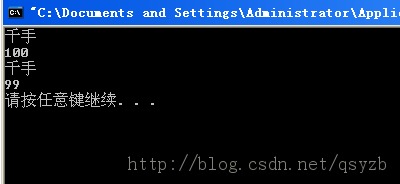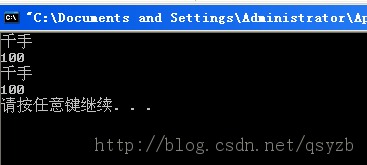结构体类型数据作为函数参数(三种方法)
#include<iostream>
#include<string>
using namespace std;
struct Student{
string name;
int score;
};
int main(){
Student one;
void Print(Student one);
one.name="千手";
one.score=99;
Print(one);
cout<<one.name<<endl;
cout<<one.score<<endl;//验证 score的值是否加一了
return 0;
}
void Print(Student one){
cout<<one.name<<endl;
cout<<++one.score<<endl;//在Print函数中,对score进行加一
}

这种方式值采取的“值传递”的方式,将结构体变量所占的内存单元的内存全部顺序传递给形参。在函数调用期间形参也要占用内存单元。这种传递方式在空间和实践上开销较大,如果结构体的规模很大时,开销是很客观的。
并且,由于采用值传递的方式,如果在函数被执行期间改变了形参的值,该值不能反映到主调函数中的对应的实参,这往往不能满足使用要求。因此一般较少使用这种方法。
#include<iostream>
#include<string>
using namespace std;
struct Student{
string name;
int score;
};
int main(){
Student one;
void Print(Student *p);
one.name="千手";
one.score=99;
Student *p=&one;
Print(p);
cout<<one.name<<endl;
cout<<one.score<<endl;//验证 score的值是否加一了
return 0;
}
void Print(Student *p){
cout<<p->name<<endl;
cout<<++p->score<<endl;//在Print函数中,对score进行加一
}

这种方式虽然也是值传递的方式,但是这次传递的值却是指针。通过改变指针指向的结构体变量的值,可以间接改变实参的值。并且,在调用函数期间,仅仅建立了一个指针变量,大大的减小了系统的开销。
#include<iostream>
#include<string>
using namespace std;
struct Student{
string name;
int score;
};
int main(){
Student one;
void Print(Student &one);
one.name="千手";
one.score=99;
Print(one);
cout<<one.name<<endl;
cout<<one.score<<endl;//验证 score的值是否加一了
return 0;
}
void Print(Student &one){
cout<<one.name<<endl;
cout<<++one.score<<endl;//在Print函数中,对score进行加一
}

实参是结构体变量,形参是对应的结构体类型的引用,虚实结合时传递的是地址,因而执行效率比较高。而且,与指针作为函数参数相比较,它看起来更加直观易懂。
因而,引用变量作为函数参数,它可以提高效率,而且保持程序良好的可读性。

